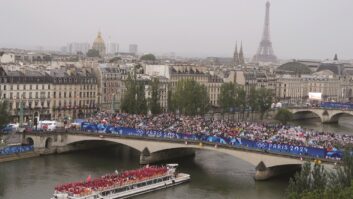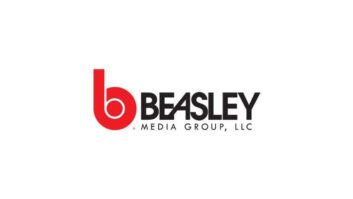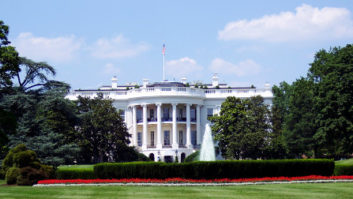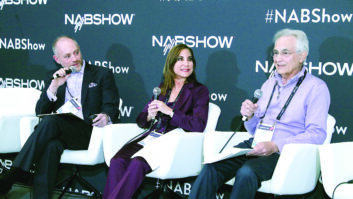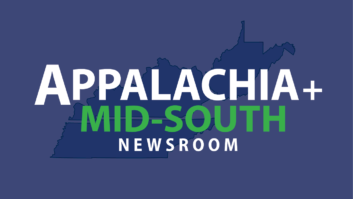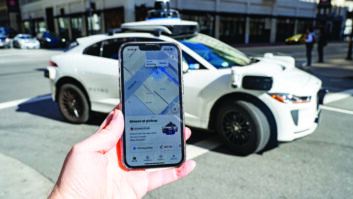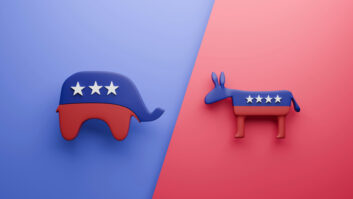WASHINGTON — The furniture chosen for the top office suite at the National Association of Broadcasters by its previous two occupants was standard Washington-type masculine: conservative dark wood and leather. Gordon Smith’s office has such pieces too, but with a change-up; the former U.S. senator from Oregon uses some furniture from his former Capitol Hill office, including a wing-back chair covered in a tasteful paisley fabric and a leather couch with a plaid fabric seat, suggesting the slightly more casual nature of the current leader of the lobbying organization.
Three months into the new session of Congress, Smith, broadcasting’s top lobbyist, is in the thick of the issues, pressing the industry’s case on Capitol Hill and at the FCC.
A two-year restriction against direct lobbying of his former colleagues is now over, and Smith is taking full advantage of the change as the trade group adjusts to the post-election leadership changes on the Hill.
Performance rights remain a hot topic in and outside the Beltway, as both broadcasters and groups backed by artists and record labels keep that issue in play. NAB’s effort to get FM chips into mobile devices remains a priority. Smith is preparing for his second NAB Show as president/CEO, and the association also is working on more changes to radio’s convention in the fall.
Radio World U.S. Editor in Chief Paul McLane and News Editor/Washington Bureau Chief Leslie Stimson spoke with Smith in his office at NAB’s headquarters.
The conversation started with discussion of performance rights and how that issue evolved after the NAB Radio Board approved a “term sheet” and presented it to musicFirst last fall. The proposal outlined a possible settlement, suggesting among other things that music-playing terrestrial stations would agree to pay a limited performance fee — between 0.25 and 1 percent of their net revenue — in exchange for backing from performers and labels for NAB’s legislative efforts regarding penetration of radio-activated mobile phones.



Gordon Smith. ‘I don’t want NAB to be seen as the House of No, but as the House of Engagement.’ Photo by Paul McLane RW: The Radio Board’s “term sheet” was a big development in one of radio’s most pressing issues. Can you bring our readers up to speed on performance rights since?
Smith: As I understand their communications to us, the other side feels that what we voted on nets out to insufficient dollars, and that their better play is to grow the digital platform and oppose us on all the other things radio wants, legislatively and regulatorily.
At the end of the day, though, it isn’t their vote or our vote. It’s the vote of Congress, and what Congress wants to do with where we ended up, that will likely drive our re-engagement on the issue.
RW: Are you still in discussions with musicFirst?
Smith: I talk with them regularly. Our position is unchanged at this point, but we remain at the table. We’re not the ones that have walked away.
Our motive in the beginning was to beat a bad bill, and to make sure that if any bill passed, it left a bright future for radio. …
Thinking long-term, the thing that radio needs is to be on the platforms for telecommunications for the future. Those are digital platforms. For all the reasons we’ve articulated in the past, as an automobile-centric industry we need to be on more than just a dashboard. Because our position on the dashboard is no longer a couple of knobs and some buttons to push. You’ve got to work to find your radio now. It’s a digital console.
If that’s getting crowded, we need to be on other platforms, like cellphones, because that’s where the people are.
And no one does for the public what radio does, which is to provide emergency information in the most efficient way that it can be received.
RW: Is it realistic to expect Congress to mandate radio on portable devices?
Smith: I said at the beginning, it’s a tough sell. I understand that.
There is a very strong public policy reason for a mandate. In an age of terrorism [and] natural disasters, there is only one signal that keeps in operation when everything else is shutting down. And that’s that radio signal, [which] is a lifeline, literally, for people in a blizzard, in a terrorist attack, in an earthquake, you name it. …
So the difference between where we were last year and where musicFirst was, and is, we said, “If we can’t get the mandate, then how about a phase-in of the market? And we would put advertising dollars into identifying those cellphone manufacturers who include an enabled radio chip, and that up to 1 percent, we would phase in, according to market adaptation.” I still think that is a good outcome. But it is not the certainty that the other side wants.
RW: You were at CES. Did you talk to cellphone carriers about this issue there?
Smith: I did, a number of them.
I’ll tell you what I infer from this. The smartphone is not yet a commodity. But within a few years it will be a commodity, and the way manufacturers will distinguish their phone from another is by having more stuff on it. For very little money, and a great deal of benefit — in an age where telephone companies are going from all-you-can eat plans to pay-as-you go, billing by the bit — we think the outlet of free radio is something that will be very appealing to moms and dads when they give their kids a cellphone.
RW: When you say commodity, you mean more affordable?
Smith: Yes, I noticed the other day the iPhone 3GS is now like $45. You’re getting into a commodity there. It’s no longer north of $500 for it. …The first in that kind of a market is the one that makes the money; so that’s Apple, a few of the BlackBerry designs.
But now several are putting in radio-enabled chips. Zune is one of those … iPod has the Nano and [there are] many others. …
A smartphone has a usable life of about 18 months. That’s the turnover rate. If we start creating awareness of the difference between paid radio and free radio, and for 25 cents extra or whatever it is — say it’s a buck — you can have free radio on there and it does these things for you, that creates a market. All things being equal, people will say “Do I want a radio chip or don’t I?” “I think I do.” That will save on my monthly bill.
RW: Satellite radio used to be the big, hot thing in consumer electronics. Now, Pandora’s getting all the buzz. Is Pandora a real threat to radio in the dash, those kinds of personalized Internet services?
Smith: They’re trying to get into what has historically been the radio space. I don’t think we know, at this juncture, at what economic level Pandora plateaus. It really depends on price.
Free is better. So that’s a downward pressure on that business.
Many people in radio have an app now. I’ve got a bunch of them on mine [holds up a smartphone]. At what point do [users] start getting billed for that? I think the telcos are making clear there will be a point at which you start getting billed for what you stream; and that’s the plateau, that’s the hydroelectric dam that those salmon are swimming up against.
RW: But what would you say to a radio manager who’s worried about Pandora-like services moving in on radio’s dashboard turf?
Smith: I’m trying to say, let’s think creatively about how we get competitive in digital spaces; and that means inclusion in the devices of the 21st century. Exhibit A is the smartphone. Again, I think there’s a tremendous public policy reason for having that — if not a mandate, then certainly encouraging the market to grow.
I think part of my job is to say, if radio eventually has to pay a terrestrial performance fee, we still believe that play and promotion are equal economic value. So if we have to pay, give us something to buy. Help radio, [which] is so essential to constituents of members of Congress, grow into the platforms of the 21st century. That’s what NAB’s got to help facilitate, and that’s what we’re doing. …
Whenever we talk about Sirius XM or a Pandora model, when you look at the economies of scale, radio is a $17 billion annual business. I doubt if any of those companies even hit one [billion]. I don’t know their numbers; but it’s wholly different. It’s like little league vs. the major league in terms of just the economics.
RW: Pandora’s claiming some 80 million subscribers. Those are people who sign up for the free service; it’s not clear how many are actually listening each day …
Smith: You buy a new car, they will either include XM Radio for six months, or they’ll show you how you can subscribe depending on how much you’re spending for the car. So they’re trying to get in there. It will find its level; but I don’t think, because of price, you’ll ever see subscription radio rivaling, in economic dollars, terrestrial radio.
I can tell you in our conversations with musicFirst the biggest difference between the two sides is how they see the future. The other side sees digital as growing like a hockey stick exponentially forever. Terrestrial radio members that we represent see it as something that has a niche and will plateau and will not grow beyond a certain level. Nobody knows what that level is.
RW: What are the priorities for NAB Radio Board members right now?
Smith: One of them isn’t even a legislative fix, and that’s … to actually monetize simulcast streaming. You can’t really do that now. They’ve got to strip out all their commercials in order to do it. So let’s come up with something that allows … that category to grow. You can’t grow it if you can’t monetize it.
Certainly CRB [Copyright Royalty Board] rates retard the growth of the digital platform. Certainly inclusion on these new platforms is a huge priority.
RW: Did you get any ideas at CES that you can translate into the NAB Show?
Smith: Yes, a number of them. We’ve come up with this new concept of a Radio Pit, where you have areas on the floor designated to the radio community [for] HD and others to share ideas and to show products. It will be more organized and centralized for the radio industry to find what they need quickly and to participate in the dialogue about where we go.
RW: Much attention is being paid to the pressure on TV spectrum by the push for broadband, and whether broadcasters will give up spectrum, voluntarily or otherwise. Why should radio managers pay attention?
Smith: They are paying attention. In fact, they are very much returning the favor that television did for them. A year ago, we ran radio and TV ads [in local congressional districts] to help defeat the Performance Rights Act. It was enormously effective. …
RW: Is there any immediate threat to radio spectrum?
Smith: Not immediate; but if they can do it to your neighbor, they can do it to you eventually.
RW: That’s what you’re saying about Genachowski’s broadband focus.
Smith: Yes, the whole thing is increasing the capacity of broadband. Which is not a bad thing; but if that translates into a world of just broadband and not broadcast, that’s a very bad thing. We’re trying to make sure that, as the debate takes shape, Congress sees a world of broadband and broadcast, where radio and television have good space; that they can continue to provide free and local service. …
So radio is running ads on radio stations throughout America in support of television spectrum.
RW: How do the recent party and leadership changes in Washington affect NAB’s outlook for the next few months?
Smith: … Divided government makes it so that things don’t happen in a rush. … It gives us more places at which to take a shot if we’re not happy. So in that sense, it means very little can be done to us in the dark of night or at the 11th hour that we would regret. … So it isn’t politics; it’s process. It gives us a stronger hand when you have divided government.
RW: There was a time when NAB was described as one of the most powerful lobbying organizations in Washington. Would you agree with that characterization today?
Smith: Yes. I think we’re proving it. It isn’t so much NAB, it’s what we do in a meaningful way in the lives of the American people; and their elected representatives know it. I’ll give you the perfect example, the one that I know, very, very well. When I would run for election I would do Internet ads, and 30 people would click on [them]. I’d do some cable ads, and I’d have to run them for a long time to get any penetration.
But if I wanted to reach my constituency, I went to broadcast radio and television and I would see my numbers move. Because that’s where the American people are. That’s where they go still, for the information that is essential to having an informed life as an American citizen. That’s why we’re a survivor, and that’s where we’re effective. Because when you meet with a member of Congress, they see local content, local faces and local jobs that are free to their constituency.
RW: You can lobby now. Has that changed how you approach the job?
Smith: Yes, it’s been a wonderful experience to be able to now call.
During the ban, I would have colleagues call me all the time and I would have to preface each call by saying, “Great to talk to you. If you’re asking something that requires advocacy, I can’t do that. If you ask me the question I will have one of my staffers get you the answer.” …
But now with that gone, I’m able to go there [to Congress] as someone fully appreciative of the role that lawmakers play. I respect the role that they have to play. I think having been there with them, they can talk to me in a way that they may not be able to talk to others about the pros and cons of any issue.
RW: How would you characterize your relationship with FCC Chairman Julius Genachowski?
Smith: I would say businesslike. …
The challenge we had the outset is that we get mixed messages. We don’t know the target, and therefore the consequences, of [the FCC’s] proposals and how they translate onto the balance sheet of our members. We want clarity of message and consistency of that message as they continue to refine what they’re going to do or what they’re proposing. We’re highly interested.
RW: Especially when he’s talking about broadband and the possible television spectrum give-backs. Broadcasters would like to know where they stand…
Smith: The chairman has been very clear that this will be an entirely voluntary process. Our objective is to “keep voluntary, voluntary.” … They want to entice broadcasters to turn in their licenses and share in the proceeds.
Let’s say you’re in a townhouse. And your neighbor, his economics aren’t yours, and he decides to torch his apartment or condo for the insurance money. Are you held harmless?
RW: No, my wall just melted.
Smith: You’ve got smoke damage. You’re damaged. As I think of spectrum, you get your neighbor channel saying, “Yeah, we want to sell out.” That’s fine if I’m held harmless; but if that means I have to be re-positioned to an inferior signal with a smaller reach, I’m not volunteering for that.
Voluntary can mutate into compulsory very easily in the whole re-packaging [scenario]. …
RW: What does the way NAB handled the LPFM situation and the outcome of that issue indicate about the way you and NAB approach problem-solving and conflict?
Smith: A perfect example … In the last Congress, we used the process to get the two things that we needed from LPFM. We wanted primacy. We got it. We wanted protection from interference. We got it. We were able to use the House rules and the Senate rules — the process to make sure that the final product had everything that we needed, and allowed them to proceed.
I said [at the outset] I don’t want NAB to be seen as the House of No, but as the House of Engagement. If there’s a public problem, we are part and parcel a public service. We’ll try to help solve it, but we want within the solution to be allowed to continue making a living and meeting payroll and providing return on investment to shareholders.
The whole point of a trade association is to make sure that the rules of the road allow the prosperity for our members. They’re all independent businessmen who will have different balance sheets and different debt concerns and shareholder concerns. But a trade association’s central … purpose is as an advocacy tool, and in that regard, NAB is a very, very effective player.
RW: And you’re satisfied that in getting it written into the LPFM language that full-time broadcasters have primary spectrum use, that that will protect them from any possible interference or…
Smith: That’s correct. And [the LPFMs] agreed to a [spacing] mechanism that makes sure that we don’t have interference.
[Our position] was always characterized easily as “We’re trying to prevent competition.” They’re not competition, in a commercial sense. …
RW: Do you foresee a day when Congress stops funding public broadcasting?
Smith: I think that we’re seeing that day. I think many in public broadcasting understand that their resources need to be less oriented to the government’s treasury and more towards the audience that they’re serving. Yeah, there’s some ideological edge in this debate, and that was exacerbated recently over Juan Williams. We’re trying to be supportive; yet I can just tell you, as you construct budgetary priorities there’s going to be a lot of pressure on things like public broadcasting and farm subsidies. The list is as long as my arm. …
RW: Can you tell us anything about this fall’s Radio Show, especially changes planned for the exhibit floor?
Smith: It’s in Chicago. Merging the show with RAB was a net positive. It creates a larger place for radio to gather for all of its activities. Certainly there was some concern about how the exhibits were done here [in Washington] in a smaller venue. We’ll have more space in Chicago, where some of those complaints can be addressed. …
RW: NAB had previously planned sales and marketing sessions with the RAB. How is it planning an entire Radio Show together?
Smith: There are economies of scale that benefit both organizations and our members. I just see it as a net plus, one stronger show rather than two competing shows.
RW: Do you do anything else with them? Are the two groups still working together to convince cellphone manufacturers to put FM chips in their devices?
Smith: Yes, our positions are the same on that. … If there’s no mandate — I grant you, that’s a tall order, legislatively — I believe a market will ultimately include, if not an FM chip, in the future it will include an HD Radio chip, which takes care of AM and FM. Because it’s [digital] I think that that’s something new that manufacturers will want to include in their phones because they’ll want to distinguish those from their competitors. They’ll want that extra feature.
RW: How would you characterize the success of digital radio in the U.S. so far?
Smith: I think it’s been mixed at this juncture; but I think it’s a chicken-and-egg kind of problem. As you see more and more automobiles including HD in their offering, I think you’ll see it take off. … Just as automobiles are not, quote, commodities, you can get the lower-end automobiles that are very much like commodities. … For very little money, you can add a feature that might mean they’ll buy this model vs. the other. HD Radio is one of those. …
RW: As a follow-up to the topic of radio and cellphones, Gary Shapiro at CEA has said radio’s acting like a buggy-whip industry, for asking for a mandate. What would you say to him?
Smith: Gary’s great at the bravado and the sound bite. Here we are being called a buggy-whip industry and every week we reach an audience of 260 million Americans. That’s better than the Betamax.
RW: He touches on a sensitive point, though, as a lot of people are pigeonholing broadcasting as archaic.
Smith: It’s a nice little sound bite that he has. But if this is a buggy whip, this is a pretty effective tool. Because it still reaches most of the American people every week. Its reach is enormous. Whatever pejorative label you want to attach to it, the funeral rites have been administered to radio for decades.
RW: CEA and NAB partner on the engineering side. Shouldn’t the trade groups be partners in other areas?
Smith: There is a community of interest between NAB and CEA. It’s just that right now, things are strained because the oxygen that they need is the spectrum we have.
So you really come down to a public policy issue of what do the American people need and want. Do they need more apps? Or do they need their local news, weather, sports and emergency information and how’s the best way to get that to them?
There’s not enough spectrum in the universe to handle video one-to-one by everyone. So do you need broadcasting in that mix? Yes, a really healthy broadcast signal. Otherwise you’ll always be in a shortage.
That’s why we keep saying the world of the future has to include us both. We are a survivor industry, an essential industry, because of our one-to-everyone signal.
Comment on this or any story. E-mail [email protected] with “Letter to the Editor” in the subject field.
